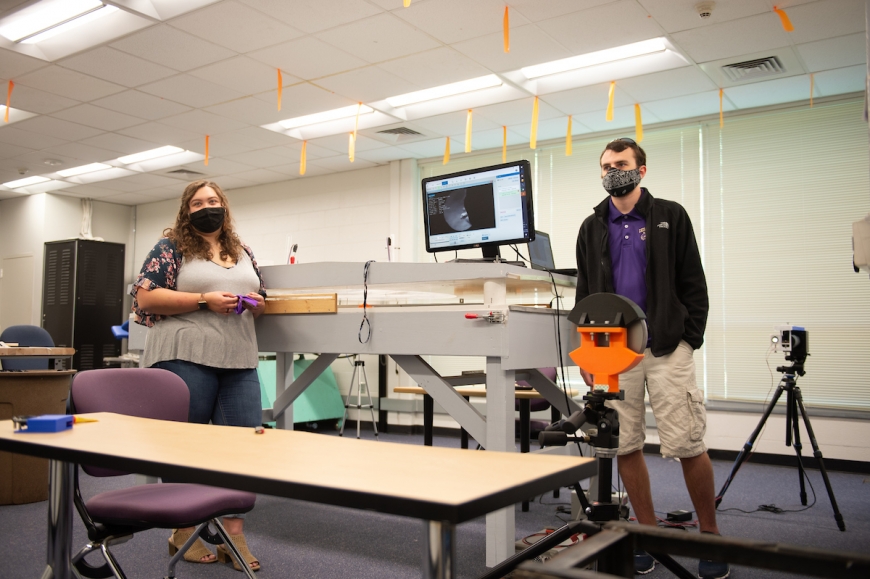But rarely do you hear people who are searching for masks wonder which one’s work the best. Students in Western Carolina University’s College of Engineering and Technology are conducting studies that could help people make more informed decisions on which one’s are most effective.
Through Schlieran imaging, a flow visualization technique that uses photography to show the flow of fluids of varying density, WCU students are in the process of conducting testing of various forms and materials of masks to show what it looks like while breathing normally, coughing, and blowing hard through masks, as well as what it looks like to do the three without wearing one.
“This is a very good technique,” said Hayri Sezer, assistant professor of engineering and technology. “It’s not available at many universities. This is a unique system and we are so happy that we are able to do this here. It’s also a very expensive system.”
Funding for the equipment came from an internal provost grant combined with funds from the Rapid Center, WCU’s engineering research and development center. It was used to purchase a high-speed camera, a concave mirror and an LED light. To help mount the camera and the mirror, students made their own plastic mounting materials using 3D printers.
The project began last spring as part of a Capstone project and was continued this fall. While the technique may seem simple, setting up the equipment has proven to be the most difficult.
“It was nice getting to see it work because for a while, we had a rough start,” said senior Brittany Holloway, an engineering technology major from Wilkesboro. “We ran into issues to where we were constantly having to readjust it. It’s still an issue sometimes, but now we’ve pretty much got it down pat to where we can fix it within a short amount of time instead of days. The slightest vibration can tilt the camera. Sometimes even as much as breathing on the mirror wrong can make it go out of sync, and then you have to go back and turn everything very slowly until you get it right.”
So far, the students have tested masks made of what they termed “jersey material,” which were the masks all students were issued at the start of the fall semester. They discovered that the airflow was mostly directed upward, rather than straight through the mask.
“Not much comes through the jersey masks when coughing, but with our blowing tests where we purposefully blow through the masks to get through it, we still can get airflow directly through the masks. But with coughing, the mask definitely helps stop the spread of anything from your mouth,” said senior Jared Beaird, a mechanical engineering student from Greensboro.
While testing neck gaiters, which are generally made with thinner materials, the students discovered they don’t work nearly as well.
“The material is thin enough that coughing, or just breathing normally, will go through the material much easier than other types,” said Beaird, who wore the gaiter during the experiment. “The material didn’t stop my breath at all. With a lot of the other masks, it’ll go upwards because the mask is stopping the airflow outward. But with the gaiter, you can see that nothing is really coming out of the top of it because it’s all going right through it.”
Sezer, who is overseeing the project along with Andy Ritenour, assistant professor of engineering and technology, said the project is in the preliminary stages. The students will continue testing different mask materials.
“The future work will be when someone blows from a mask, we want to see the particle size that are ejected from these masks,” Sezer said. “We can use a micro lens, which will be able to visualize the size of the particles with the Schlieren imaging system.
“That will tell people the sizes of the particles that will be ejected from these masks. For example, with coronavirus, I am not positive, but the size is about 50 to 200 nanometers. If the particle size that’s released from here is larger than the coronavirus particles, then we can say these are the particles that can carry the coronavirus inside it.”
